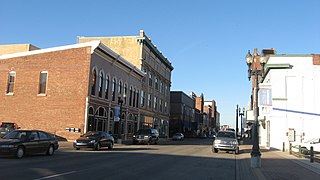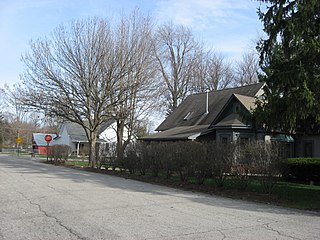
Chatham–Arch is a neighborhood located immediately east of Downtown Indianapolis, Indiana, United States. This neighborhood is one of the oldest in Indianapolis, dating back to the mid 19th century. Chatham–Arch contains many of Indianapolis's historic homes.

The Riverside Historic District is a U.S. historic district located in downtown Evansville, Indiana. It was added to the register in 1978 and roughly bounded by Southlane Drive, Walnut, Third, and Parrett Streets. It consists of 1,010 acres (4.1 km2) and 425 buildings. It is also known as the Riverside Neighborhood.

Independence Historic District, also known as the West Franklin Street-Wabash Avenue Historic District, is a national historic district located in the Lamasco neighborhood of Evansville, Indiana. The district developed after 1880, and encompasses 95 contributing buildings and 1 contributing site. It includes commercial and residential properties and representative examples of Italianate, Queen Anne, Romanesque, and Beaux-Arts style architecture. Notable buildings include the West Branch Carnegie Library (1912), Laval Block, Heldt-Voelker Hardware Store (1890), First Federal Savings, Gerke Building, August Rosenberger House (1894), and St. Boniface Church.

First Baptist Church is a historic Baptist church located at 309 E. Adams Street in Muncie, Indiana. The Late Gothic Revival building was designed by Samuel Hannaford & Sons and constructed in 1928-1929 by Morrow & Morrow. It is constructed of Indiana limestone and has a cruciform plan. It features and engaged five-story tower.

Goldsmith C. Gilbert Historic District is a national historic district located at Muncie, Delaware County, Indiana. It encompasses 75 contributing buildings and is located in the oldest residential section of Muncie. The district includes notable examples of Late Victorian, Colonial Revival, and Bungalow / American Craftsman style architecture. Located in the district is the separately listed J.C. Johnson House. Other notable buildings include the A.L. Johnson House, Meeks Mortuary Building, Joseph Hummel House, and Miller Livery (1916).

Walnut Street Historic District is a national historic district located at Muncie, Delaware County, Indiana. It encompasses 66 contributing buildings and 1 contributing object, and is located in the central business district of Muncie. The district includes notable examples of Italianate, Late Victorian, Colonial Revival, and Beaux-Arts style architecture. Located in the district are the separately listed Moore-Youse-Maxon House, Roberts Hotel, and Goddard Warehouse. Other notable buildings include the Patterson Bock, McNaughton Block (1901-1903), Mitchell Block (1909), American National Bank Building (1924), Marsh Block (1888), and the Old Post Office designed by the Office of the Supervising Architect under James Knox Taylor.

Wysor Heights Historic District is a national historic district located at Muncie, Delaware County, Indiana. It encompasses 61 contributing buildings, 1 contributing site, and 1 contributing object in a predominantly residential section of Muncie. The district developed between about 1890 and 1930, and includes notable examples of Queen Anne, American Foursquare, and Bungalow / American Craftsman style architecture. Notable contributing resources include the equestrian sculpture and landscape ensemble "Appeal to the Great Spirit" by Cyrus Edwin Dallin (1929), Roy Thomas House (1922-1923), Burt Whiteley House (1892), and the first Delaware County Children's Home building.

Westwood Historic District is a national historic district located at Muncie, Delaware County, Indiana. It encompasses 83 contributing buildings and 1 contributing site in a predominantly residential section of Muncie. The district developed after 1923, and includes notable examples of Colonial Revival, Tudor Revival, and Bungalow / American Craftsman style architecture. Notable buildings include the William H. Ball House (1925), Alexander Bracken House (1937), Michael Broderick House (1928), Bennett Heath House, and Fred Kencht House (1932).

Riverside Historic District is a national historic district located at Muncie, Delaware County, Indiana. It encompasses 74 contributing buildings and 1 contributing structure in a predominantly residential section of Muncie. The district developed between about 1895 and 1949, and includes notable examples of Colonial Revival, Tudor Revival, and Bungalow / American Craftsman style architecture.

Meeks Avenue Historic District is a national historic district located at Muncie, Delaware County, Indiana. It encompasses 25 contributing buildings in a predominantly residential section of Muncie. The district developed between about 1904 and 1939, and includes notable examples of Bungalow / American Craftsman style architecture. A notable building is a service station constructed in 1939.

Kirby Historic District is a national historic district located at Muncie, Delaware County, Indiana. It encompasses 25 contributing buildings in a predominantly residential section of Muncie. The district developed between about 1839 and 1930, and includes notable examples of Greek Revival and Colonial Revival style architecture. Notable buildings include the Thomas Kirby House (1839), William F. Spencer House (1909), John Fitzgibbons House (1918), Theopharia A. Hough House (1909), Pearl Hopkins House (1893), and Edward R. Templar House (1905).

Drover Town Historic District is a national historic district located at Huntington, Huntington County, Indiana. The district includes 231 contributing buildings, 2 contributing structures, and 1 contributing object in a predominantly residential section of Huntington. It developed between about 1857 and 1930 and includes notable examples of Federal, Greek Revival, Gothic Revival, Italianate, and Queen Anne architecture style architecture. Located in the district are the separately listed German Reformed Church, Samuel Purviance House, and William Street School. Other notable buildings include the William Drover House, John Rhoads House (1896), and Griffiths Block (1896).

Old Plat Historic District is a national historic district located at Huntington, Huntington County, Indiana. The district includes 177 contributing buildings and 2 contributing structures in a mixed residential section of Huntington. It developed between about 1860 and 1920 and includes notable examples of Greek Revival, Gothic Revival, Italianate, and Queen Anne style architecture. Notable buildings include the Mathew Luber House, George W. Humbert House, Trinity Methodist Episcopal Church (1914), First Church of Christ Scientist, and Masonic Temple (1926).

West LaSalle Avenue Historic District is a national historic district located at South Bend, St. Joseph County, Indiana. It encompasses 33 contributing buildings and 2 contributing structures in a predominantly residential section of South Bend. It developed between about 1870 and 1930, and includes notable examples of Italianate, Queen Anne, Late Gothic Revival, and Beaux-Arts style architecture and works by architects Austin & Shambleau. Notable buildings include the St. Peter's Church (1927), Lydia Klinger House (1900), Woodworth House, Woolman House (1880), Goetz House (1892), Studebaker House, Kuppler House (1885), and the Gunderman House.

Ellsworth Historic District, also known as Ellsworth Addition, is a national historic district located at Lafayette, Tippecanoe County, Indiana. The district encompasses 144 contributing buildings, 1 contributing site, and 4 contributing structures in a predominantly residential section of Lafayette. It developed between about 1844 and 1936 and includes representative examples of Italianate, Second Empire, Queen Anne, and Bungalow / American Craftsman style architecture. Located in the district are the separately listed Falley Home, Moses Fowler House, and Temple Israel. Other notable buildings include the Second Presbyterian Church (1894-1895), Alexander House, Ball Brothers House, Falley Townhouse, Home Block, Annie Fowler House, and Duplex Townhouse.

New Augusta Historic District is a national historic district located at Indianapolis, Indiana. It encompasses 114 contributing buildings, 1 contributing structure, and 1 contributing object in a railroad oriented village in Indianapolis. The district developed between about 1852 and 1939, and includes representative examples of Italianate and Bungalow / American Craftsman style architecture. Notable contributing buildings include the Odd Fellows Building, Hopewell Evangelical Lutheran Church, Salem Lutheran Church (1880), and New Augusta Depot. It is located west of Augusta.

North Meridian Street Historic District is a national historic district located at Indianapolis, Indiana. It encompasses 169 contributing buildings in a high style residential section of Indianapolis. The district developed between about 1900 and 1936, and includes representative examples of Tudor Revival, Colonial Revival, and Classical Revival style architecture. Located in the district is the separately listed William N. Thompson House. Other notable contributing resources include the Evan-Blankenbaker House (1901), Sears-Townsend House (1930), MacGill-Wemmer House, Hugh Love House (1930), Hare-Tarkington House (1911), Shea House (1922), and Brant-Weinhardt House (1932).

Horace Mann Public School No. 13 is a historic school building located at Indianapolis, Indiana. It was designed by architect Edwin May (1823–1880) and built in 1873. It is a two-story, square plan, Italianate style red brick building. It has an ashlar limestone foundation and a low hipped roof with a central gabled dormer. A boiler house was added to the property in 1918.

Flanner House Homes is a national historic district located at Indianapolis, Indiana. The district encompasses 180 contributing buildings in the Project Area "A" of Indianapolis. It was developed between about 1950 and 1959, and include single family and duplex dwellings for African-American families. Notable buildings include the Revival Temple Church.

Holy Rosary–Danish Church Historic District, also known as Fletcher Place II, is a national historic district located at Indianapolis, Indiana. The district encompasses 183 contributing buildings in a predominantly residential section located in the central business district of Indianapolis. It was developed between about 1875 and 1930, and include representative examples of Italianate, Gothic Revival, Tudor Revival, and Renaissance Revival style architecture. Located in the district is the separately listed Horace Mann Public School No. 13. Other notable buildings include the John Kring House, Trinity Danish Evangelical Lutheran Church (1872), John Wands House (1857), Henry Homburg House, Samuel Keely House, Maria Wuensch Cottage, and Holy Rosary Catholic Church (1911-1925).




























